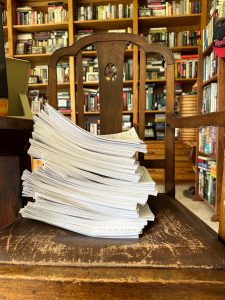Some Heavy Reading in Graduate School
 I have survived the two online graduate courses begun in January at the University of North Texas, seeking a certificate in archival management under a grant the R.G. LeTourneau Archives received last year. It was touch-and-go for a time. The digital curation course in particular at times seemed akin to learning a new language. I would read the assignment and realize I had absolutely no idea what was required of me.
I have survived the two online graduate courses begun in January at the University of North Texas, seeking a certificate in archival management under a grant the R.G. LeTourneau Archives received last year. It was touch-and-go for a time. The digital curation course in particular at times seemed akin to learning a new language. I would read the assignment and realize I had absolutely no idea what was required of me.
I learned how to create and compare checksums for example, which I never knew existed. A checksum is a digital identifier consisting of letters and numbers that is assigned to a dataset. A dataset is simply a collection of digital files, such as might be created during research. Increasingly, researchers in many fields are required by their grant funders to save their data somewhere and make it accessible to others for further research. The checksum helps ensure that the file being copied or transferred has survived the digital voyage unchanged. For one assignment, I had to copy a file and run a program I did not even existed on my iMac to determine if the file copied over had the same checksum.
I could not decide if this was a trick or not on the part of the professor. The checksum consisted of about 20 characters, both letters and words. I probably “checked” the checksum 10 times before concluding they were indeed the same and averring so for the assignment. That was the correct answer. Whew.
The photo accompanying this piece displays a large stack of paper on the chair next to my home office desk. It measures 8.5 inches in depth, and that old chair’s seat is groaning under the weight. That stack is what I had to read for the two graduate courses. I hated killing off another Southern pine turned into paper, but there was no way I could retain even a small portion of the material represented here without printing it, underlining relevant passages, and then writing those passages into my notes file for each course. This is about 65.8 square feet of paper by my calculations.
This is the first time I have taken an online class, and the first academic class of any kind I have taken in 37 years, which appeared to be the approximate age of both my professors. Both either recorded lectures accompanied by PowerPoint slides, or just uploaded the PPTs. Besides the reading material, there were a bevy of videos, most of which were fairly short, though there were a couple that rivaled an episode of Yellowstone in length, though not nearly as compelling.
Both of my professors were young, (compared to me), possessed doctorates, of course, and certainly knew the material and how to teach it. They were very responsive to my questions, one in particular. She would reply to my email usually within minutes, even on the weekend. The other was not quite as quick on the email-reply trigger, but she always came through. Both were reassuring and helped me gain a measure of self-confidence I did not have at the beginning of the semester.
I will earn another three hours this summer working in the LeTourneau archives, digitally uploading items to the Portal to Texas History, which is operated by UNT and is a true Texas treasure. Click on the link and type in LeTourneau to see what has already been uploaded, more than 1,000 items. We have a long way to go, but we are making progress.
In the fall, Lord willing, I will return online for six more hours to complete the program. At least I will approach those two courses with far less trepidation that the first two I took. And by semester’s end that old chair doubtless will be again sagging under the weight of all that paper.
Leave a reply
Fields marked with * are required











